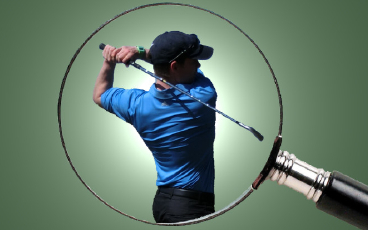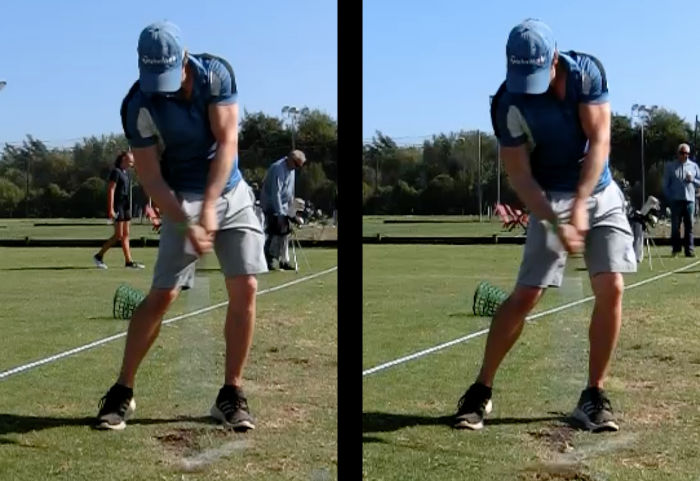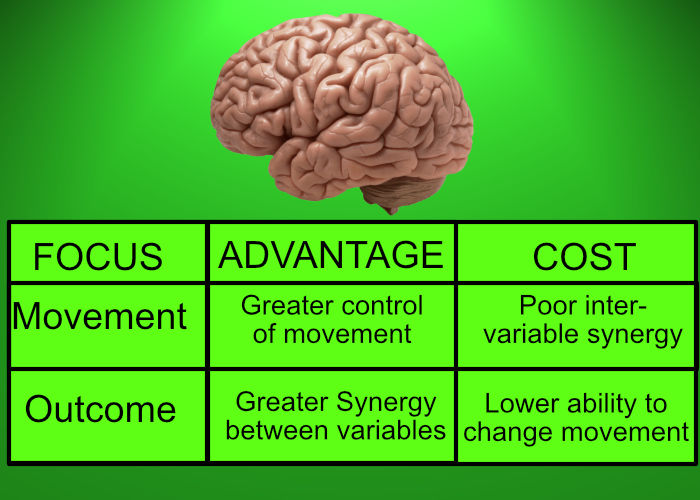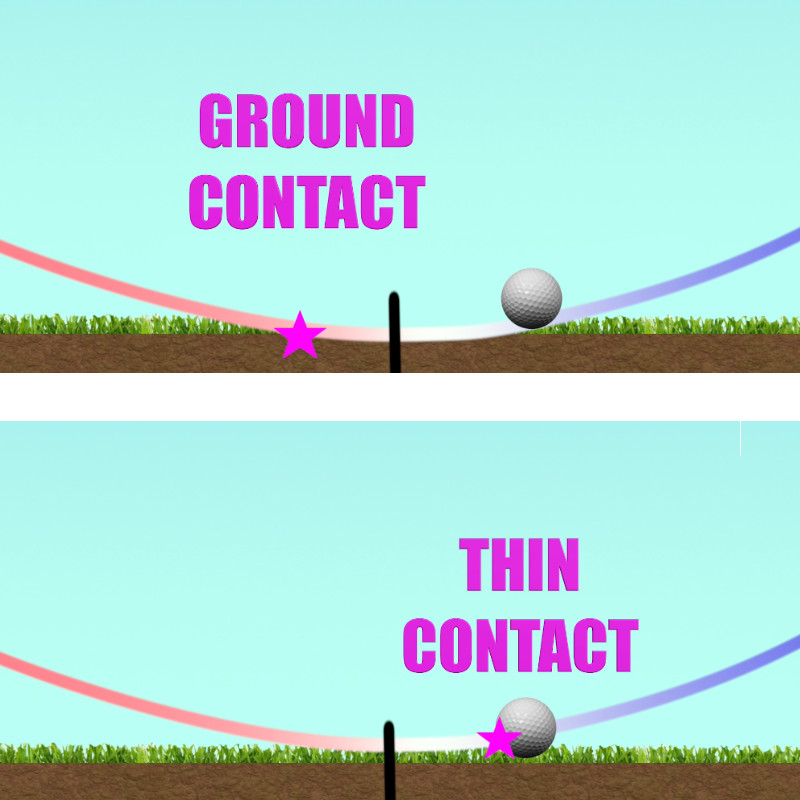The Hidden Secret To A Great Golf Swing
Golf tips
As I’ve alluded to In many different articles before, the difference between a great shot and an awful shot can often be minuscule.
 As an example – say you hit a perfect ball-turf strike on one swing. If, on the very next swing, you made an almost identical movement pattern but dropped just 1/2 an inch deeper, that could equate to now striking the ground as much as 3 inches behind the ball (depending on angle of attack and low point position). Hitting the ground behind the ball creates a layer of dirt/mud between the face and the ball. This lowers distance and would make you miss the green.
As an example – say you hit a perfect ball-turf strike on one swing. If, on the very next swing, you made an almost identical movement pattern but dropped just 1/2 an inch deeper, that could equate to now striking the ground as much as 3 inches behind the ball (depending on angle of attack and low point position). Hitting the ground behind the ball creates a layer of dirt/mud between the face and the ball. This lowers distance and would make you miss the green.
That would make it a disaster.
The Tour Swing
 Just look at any tour player.
Just look at any tour player.
You know they only hit the fairway 60% of the time, right?
Think about that. So when they miss the fairway, it’s likely that they;
- Had a tour quality grip
- Had a tour-level set-up
- Made a full shoulder turn
- Shifted their pressure/weight like a tour player
- Made a nice follow through
- Had an awesome sequence
And much more – yet they still hit it poorly.
"But I thought all the above were keys to a good swing?”
They are! But they don’t guarantee anything.
Macro Versus Micro
The above things, and the things that most golfers focus on are classed as macro techniques – or gross motor patterns. They are the big-muscle moves – the stuff that’s pretty easy to see on camera.
But the real secrets – the ones that create the difference between your best and worst swings (and the ones that define how well a tour player is playing that week) can often be found in something called “micro-mechanics”.
Micro-mechanics in golf are the smaller movements – the things that might be imperceptible to even slow-motion cameras (hence “hidden secret”). A bit of scapula retraction here, a tiny bit of lead arm flex there, or even a combination of a few millimeters of movement in a few parts of the body.
Fine-motor skills.
We see the function and style of the watch – and we know that it is the gears and cogs (the macro mechanics) which make it work. However, every single tooth on each cog needs to be perfectly aligned (the micro-mechanics or it won’t function) – just like in golf.
More About Micro
A golf swing has so many moving parts and joints where movement could occur from. Any swing could include more/less;
- Arm extension
- Forearm supination/pronation
- Wrist flexion/extension
- Ulnar/radial deviation
- Spine extension, flexion, side-bend
- Hip rotation, shift, thrust and lift
- Knee flexion/extension
Change one of the above by 1 degree and you won’t see much change in ball flight. However, change all of the above by 1 degree and you might see a whole different result.
News-Flash
The golf swing DOES change every time.
Even at the elite level, micro-technique variability has been shown to occur even in a static environment (such as hitting balls into a net). And this variability is enough to create the difference between our bad and good shots – this is why two swings can look identical on camera yet produce very different results.
And it bugs the hell out of golfers.
A s I mentioned in “why your golf swing changes every time” – one of these was a good shot and one flew 30 yards short due to a poor ground contact. The differences in body motion are minuscule.
A Game Of Two Games
The golf swing could be seen as having two goals.
- The gross motor pattern (macro) gets us into the ball-park. It creates the speed, the overall look/style of the swing and puts us in position to play good golf. It also creates our general patterns.
- But the fine motor skills (micro) determine whether our golf swing functions or not. It’s the glue that holds everything together. If you don’t have good control of the micro-movements, that great looking golf swing will not function very well – but it will look awfully pretty.
The macro movements determine how good your best golf could be. Your micro movements determine whether you play YOUR best golf or not.
Read that last paragraph again.
Improving The Micro
So the question is, how do we improve the micro?
Think of it this way – with the soup of moving parts we have (all moving differently every time we swing a club), our goal is not to minimize those movements, but to help them coordinate together better.
Synergy.
You are unlikely to improve the movement synergy by focusing on the body movement directly – this is the irony. Say, for example, you try to focus on the 1 degree of arm flex you may or may not be randomly adding – sure, you will gain control over this (to a certain extent), but at the cost of the coordination of all the other 100 moving parts.
We know, from the research in motor learning, that movement synergy is improved when there is a focus on the movement outcomes. For example, darts players who focused on the arm movement (the macro mechanics) improved the control of the mechanics, but at the expense of a poorer result (due to poor synergy between the micro-mechanics). The reverse was true. (Lohse Et al. 2010)
For elite golfers, this might be a focus on the target/result/shot shape. For lesser golfers, this could be a focus on how the club is being moved through space.
 It’s as if we give our brain a single goal, and our brain then organizes all the moving pieces in a way which will achieve that goal.
It’s as if we give our brain a single goal, and our brain then organizes all the moving pieces in a way which will achieve that goal.
The biggest irony of all of this is that 99% of golfers try to minimize outcome variability by focusing on the macro moves – working on their swing. Again, while this gets us into the ball-park, it also tends to hurt our synergy of micro-mechanics.
Not To Say…
Don’t misquote me, this is not to say that working on your swing is bad – on the contrary. Changing the big movement patterns can certainly improve performance, especially if you have “ball-park” issues.
If you want to change your general patterns, usually you will find answers by looking towards the bigger movements.
However, ultimately, as the PGA tour shows – we will always be at the mercy of our micro-mechanics when it comes to playing our best golf. Even pro-level swings don’t hit targets every time.
CHECK OUT TIGER WOODS’ NIGHTMARE ROUND
Example Time
For some golfers, these micro-mechanics affect their games more than others.
Take the example of a player who has their low point behind the ball. (Imagine the bottom of the swing arc (black line) being behind the ball)
Sure, they could hit a decent shot, if their control of their swing height (arc-depth) is impeccable. However, a subtle drop or raise in arc height would produce a big fat shot or a bladed shot.
 On the other hand, a player who has their low point in front of the ball is less affected by the same rise/drop in height. Sure, they would hit it fat/thin, but not by nearly as much. (When the lowest point of the swing arc is in front of the ball (macro), and small rise/drop in height (micro) affects the ground contact and result less.)
On the other hand, a player who has their low point in front of the ball is less affected by the same rise/drop in height. Sure, they would hit it fat/thin, but not by nearly as much. (When the lowest point of the swing arc is in front of the ball (macro), and small rise/drop in height (micro) affects the ground contact and result less.)
So the player with the low point behind NEEDS better control over their micro-mechanics. A subtle drop in height caused by (for example) half an inch drop of hip-height will kill their strike. The player with the low point in front of the ball will be less susceptible to any variability in micro-mechanics.
 However, BOTH players would benefit from an improvement in the micro-mechanics. The pros have both at their disposal – swings which have bigger margins for error AND better control over the micro-mechanics.
However, BOTH players would benefit from an improvement in the micro-mechanics. The pros have both at their disposal – swings which have bigger margins for error AND better control over the micro-mechanics.

